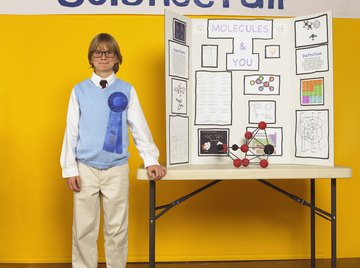
Testable projects, which test a hypothesis for results, work well for science fairs because they allow for demonstrations and not just a simple display board of information. Though curriculums vary from district to district, seventh grade science topics are often comprised of biological sciences, including organisms and cells, genetics and evolution; physical sciences, such as basic chemistry and physics; and earth and space sciences, including meteorology, earth structure and the origin of the universe. Curriculums also call for a focus on investigation and experimentation, offering great ideas from which to develop a testable science fair project.
Biology
What’s that smell? That is your science fair project. Write a hypothesis about which type of cheese will first develop mold when stored at the same temperature for the same length of time. The amount of mold may also be included within the projected experiment results. Airborne mold spores can reproduce quickly, when given the appropriate surface and substance. The higher the moisture content, the more mold is likely. Choose several types of cheese, gather an equal-sized slice of each, place them in the same container and watch daily to record the changes over a week or two. Various types of bread could be used instead of cheese.
Chemistry
Experiment with fizz. How long does it take for soda to lose its carbonation? Does extreme heat or extreme cold affect it? Create a hypothesis guessing how temperature affects a carbonated drink. Purchase three bottles of the same soda, checking for similar expiration dates, and open and reseal each bottle. Leave one bottle at room temperature, place one in a cold atmosphere and set the third in a warm area. Check carbonation after a week. If there are no noticeable changes, wait another week and check again. Record all findings.
Physics
Magnets are fun for everyone. Investigate how magnetic poles function and then develop an experiment showing off your new knowledge. A maglev is a train that runs on magnetic levitation, being propelled along the track by polar force. What else could run on magnetic levitation? Create and test a hypothesis on the success of using magnets to transport an object or person. Design a scale model for demonstration.
Meteorology
Does the wind blow more often from one direction than another? Set up a weather vane in a windy location and observe the direction at the same time each day. Record the direction once in the morning, once in the afternoon and once in the evening. For more accurate results, monitor the wind direction for a minimum of two weeks. At the end of the experimenting phase, create a chart or graph displaying from which direction the wind most often blew and suggest why that might be the case.
References
About the Author
Writing since 2008, Marisa Hefflefinger's work has appeared on websites such as SuperGreenMe, Jennifer McColm and Character Odyssey. She holds a Bachelor of Science in English education and a Master of Arts in teaching literacy and language, and she is currently working on a Ph.D. in critical literacy and English education.
Photo Credits
Brand X Pictures/Brand X Pictures/Getty Images
